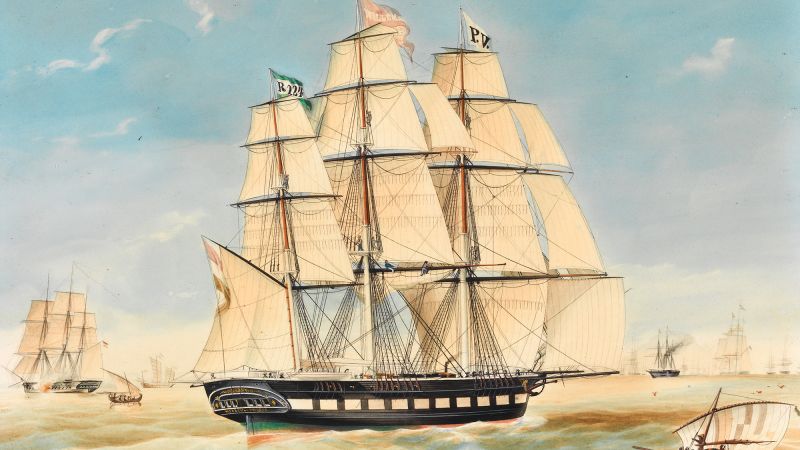In a remarkable recent discovery, marine archaeologists operating off the south coast of Australia have unearthed the wreck of the long-lost Dutch merchant ship, the Koning Willem de Tweede, which sank nearly 170 years ago. This shipwreck sheds light on a tragic chapter in maritime history, particularly during the turbulent period of the 19th-century Australian gold rush. The discovery was announced in a report issued by the Australian National Maritime Museum.
The Koning Willem de Tweede, an 800-ton sailing ship, embarked on its final voyage back to the Netherlands in June 1857. Unfortunately, its journey was cut short when a violent storm capsized the vessel close to Robe, a port town in South Australia. This calamity resulted in the drowning of two-thirds of its crew. Timely context reveals that just prior to the disaster, approximately 400 Chinese laborers, destined for gold mines in Victoria, had disembarked from the ship. James Hunter, the acting manager of maritime archaeology at the museum, noted that transporting these laborers was an additional means for the crew to earn money—a practice that was both common and legally ambiguous at the time.
While the captain survived the harrowing experience and later pursued legal action regarding his losses, the remains of the crew members tragically remain unfound, resting somewhere in the nearby sand dunes at Long Beach. After three years of extensive research and diving expeditions, a team of divers, aided by the Dutch Ministry of Foreign Affairs and the Netherlands’ Cultural Heritage Agency, finally spotted the submerged vessel’s remains on March 10. Hunter described the moment of discovery, noting that “luck plays a role in our endeavors,” as the shifting sands had briefly revealed parts of the wreck that allowed for identification and a tangible connection to history.
The team, buoyed by significant evidence such as the vessel’s location and historical specifications, determined with confidence that they had indeed identified the Koning Willem de Tweede. The measured length of the metal remains aligned with historical accounts of the ship, which documented a length of 140 feet (43 meters). To further support their claim, pieces of 19th-century Chinese ceramics were discovered on the beach near the wreck site, providing additional context to the ship’s story.
Maritime archaeologist Patrick Morrison, who was not part of the discovery team, commented on the significance of such finds, asserting that ships like the Koning Willem de Tweede were substantial investments, meticulously documented. He explained that materials discovered from shipwrecks can often be matched with historical records regarding the sinking and ship construction, giving vital insights into maritime history.
Moving forward, the Australian National Maritime Museum, collaborating with the Silentworld Foundation, South Australia’s Department for Environment and Water, and Flinders University in Adelaide, is now set to explore the wreck further. Their aim is to recover and preserve artifacts from the wreckage, which may offer deeper insights into 19th-century shipbuilding practices, the crew’s lives, and the experiences of the passengers.
Australia’s historical role as a hub for maritime trade has resulted in approximately 8,000 sunken ships and aircraft believed to lay hidden near its shores, some dating back to the 1700s, according to the Australian government. The mid-19th-century gold rush era marked an influx of Chinese laborers, enticed by the opportunity for wealth, leading local authorities to impose a hefty tax on migrants to Victoria, the equivalent of more than $1,300 today. To evade this financial hurdle, agents in China frequently hired European merchant ships to transport Chinese migrants to different Australian ports.
The Koning Willem de Tweede was originally intended for trade between the Netherlands and the Dutch East Indies, now modern-day Indonesia. Before it could return home, its crew made a stop to pick up Chinese migrants from Hong Kong, delivering them to Robe—more than 365 miles (400 kilometers) west of the main ports in Victoria. The details surrounding this trip and whether it was approved by the ship’s owners remain shrouded in uncertainty.
Community efforts in Robe have historically focused on answering lingering questions about the wreck and its lost crew. Hunter recounts a poignant story of an Indigenous Australian attempting to rescue the captain during the storm, highlighting the collective memory and dedication of the local community towards the shipwreck’s legacy. Should recovery efforts successfully locate the remains of the crew members, Hunter anticipates that the Robe community would provide them with a respectful burial site.
The significance of shipwrecks is underscored by Morrison, who emphasizes that these remnants reveal much about Australia’s longstanding maritime connections with the wider world, influencing the fabric of towns and cities even today. The ongoing exploration of the Koning Willem de Tweede and the stories it carries mark the beginning of a new chapter in maritime archaeology.
Concerning the current state of the shipwreck itself, early assessments suggest that much of the hull remains intact beneath layers of sand. Utilizing metal detectors and magnetometers, divers have located significant



